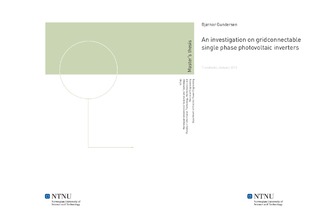| dc.description.abstract | Several inverter topologies for use with power conditioning of photovoltaic modules were investigated with both national and international requirements in mind, as well as also practical challenges and the ability to be user friendly for ordinary people. A good inverter topology should also be low cost, have a high efficiency and have a good output power quality. In addition several filter possibilities was investigated, and it was concluded that the LCL-filter was the best for the given conditions, since it attenuated the unwanted frequencies the best with relative small filter parameters. Five different inverter topologies was then presented and investigated: A hybrid multilevel inverter, a full bridge inverter, a series resonant buck-boost inverter, a flyback converter with unfolding H-bridge inverter and a series resonant converter with unfolding H-bridge inverter. After an investigation of the above mentioned criteria, two of the inverter topologies, the H-bridge inverter and the hybrid multilevel inverter, were considered better than the rest for the given requirements and purposes. These were then closer analysed with the computer simulation programs SIMULINK and SPICE in order to find quantitative arguments about which topology was the best under the above mentioned conditions. Filter parameters were also quantified. From this it was found that the hybrid multilevel inverter was 0.5 to 1 percent point more effective than the H-bridge, at the same time the total harmonic distortion was significantly better, approximately five to ten times better than the H-bridge inverter s total harmonic distortion. This means that the hybrid multilevel inverter may have a considerably cheaper filter. Both of these factors contributed so that the hybrid multilevel inverter was regarded the better topology and this topology was selected for further tests. The last simulation was about finding good switches to equip the hybrid multilevel inverter with. Here it was found that the decisive factor for the low voltage bridge was quick switches, whereas for the high voltage bridge it was more important to have switches with low resistance when turned on. The chosen switches were STY60NK30Z and BSC520N15NS3 G for the low voltage bridge. In addition it was meant to perform a laboratory experiment with the selected topology, but because of a delay with the deliverance, the test object did not arrive at time, so the experiment could not be done. | nb_NO |

